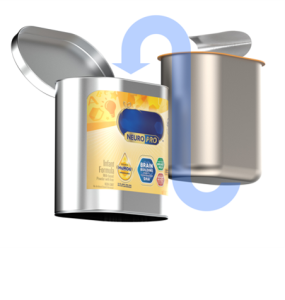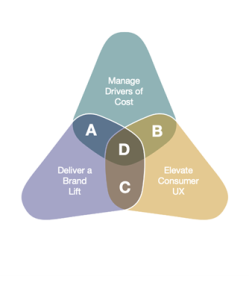eCommerce: A Match for Sustainable Offerings
eCommerce has done something monumental in changing consumer consumption patterns that have previously existed for many decades. Retail environments, such as general stores or specialized outlets, have enabled consumers to satisfy their immediate purchasing wants with various goods available onsite and in hand. This expectation changed when eCommerce enabled a new kind of convenience, the ability to browse vastly more items virtually and decide which items were best desired based on a personal matrix of selection choices, such as the best price, quality, performance, brand, lifestyle fit, and when should they be delivered. These dimensions of convenience are a kind of personalization and replace the instantaneous gratification of the product in hand with ensuring that the consumer has found the best match for their unique combination of needs, desires, and values.
This delay between purchasing and receiving the item creates an extraordinary opportunity for new forms of product experience to emerge in eCommerce. These eCommerce experiences will also enable sustainability because brands need to reduce producer responsibility, especially when cost savings are always in continual demand.

The eCommerce Buying Process Builds Personalization and Connection
In an earlier SES blog, “The Real Secret of eCommerce Success…Grace”, Clint Haynes, SES Force-4 Sr. Vice President, lays out his rationale for the concept of eCommerce’s “first moment of grace” (FMOG). In short, this is the consumer inclination to be lenient with the condition of goods coming through eCommerce as long as the core function is not damaged. One way to see this leniency is partly because the consumer was empowered through the online selling process to make their personalized choice. They feel more ownership in their purchase decision, not limited to just one store’s limited curation of goods. It often takes a day or more for the item to arrive. This outweighs the desire to go through a labor-intensive exchange or return process despite the purported easiness of returns by Ecomm retailers. If the product works and is reasonably intact, it will not have to be pristine for many lower-price goods with a limited life span or just the outer secondary packaging of something more expensive. Now, if we consider damage directly to something highly durable, long-lasting, or fine, like a watch or smartphone, this grace will likely not be the case. Only in cases where the purchase was so rare or so cheap will the damage be tolerated because its replacement is improbable or too time-consuming.
Building on this idea of consumer grace, FMOG is a physical touchpoint with the consumer whose roots go back as far as exchanging good money for a product they cannot see or touch.
The eCommerce buying activity sets up and masks a delayed gratification cycle in consumers’ minds. One gets empowered initially with all these purchasing choices but then waits. That wait sets up anticipation and paves the way for reflection on a disagreeable time-labored process for returns etched into the consumer mindset. (Not wanting to deal with more delayed gratification) When the consumer gets their item, and it’s slightly altered, they play back in their mind knowingly, or intuitively, the time it will take to return the item in hopes of having a better go at it with the next shipment. Many times, it’s not worth it. This might be a short-term win for the brand but may limit future purchases because of a negative experience. If possible, consistency is still essential for the brand reputation and prospect for loyalty through repeat purchase.
The Conditions That Kick Off Reimagining a Package – What’s Next
A structural package system can be used in the market for up to 5-7 years, some much longer, before requiring a total redesign. Brands often seek to extend the life of most packages with brand sustainment iterations of graphics label changes or packaging color and finish. Other changes include lightweighting the material and optimizing fulfillment logistics. The typical business conditions for pack change include managing rising costs, adjusting to competition or trends, changes in product, or the desire for new growth. These are all ultimately about remaining competitive and delivering shareholder value.
Sustainable Packaging is a Fit for an Imperfect Presentation

The meaningfulness of sustainability varies greatly depending on the consumer. The purchase demand potential of a more sustainable product also matters greatly depending on the type of consumer. Some consumers actively seek out and evaluate a product’s sustainability benefits. Other consumers could care less; there is nothing in it for them. Some still actively avoid offerings claiming sustainability, distrusting their value and purpose. Value in the form of novel experience and cost savings will be paramount for these consumers in connection with products and packages having a professed sustainability advantage.
Some sustainability improvements, such as refilling and reusing product packaging, can complement an initial FMOG visual impression that need not be perfect or aesthetic. These examples have a strong value component and sustainability improvements, including less material, weight, and shipping costs. In some instances, the overall use experience can be delightful and novel.
Examples of refill and reuse exist in food, beverage, and cosmetics. A typical approach is to have a durable container, rather than single-use options, with a replaceable refill unit. The refill can go inside the durable container or empty its contents into it.
The refill will be scrutinized much less when it arrives at the consumers’ door. It is just a temporary medium for its content, which will be dropped into or poured into the durable container, device, or applicator.
In these instances, it may mean more carefully protecting the original durable container in the system, but the multiple refills used over time can be packaged leaner and more cost-consciously.
The long life of a single reusable packaging item eliminates hundreds of single-use packaging items from entering the landfill, reducing solid waste by up to 86%.
-Reusable Packaging Association
The Prevailing Trends of eCommerce and Sustainability Are Shaping What’s Next in Packaging and Products
Ease of use and convenience. Getting the consumer to accept reduced levels of convenience is very difficult or, in most cases, a losing strategy; most successful products deliver delight in part because the amount of effort going to the use of something is perceived much less for what they get out or what the product does for them. There must be something competitively better in the performance or experience to accept change, including sustainability.
Brands will consider adding new levels of premium impression to the primary package and the product- elevating value, quality, and even prestige. These more invested approaches will bank on reversing any race-to-the-bottom, focused on things that are marvels to behold and hold.
For consumer package goods, this will make packages look more like innovative products, not just cost-efficient containers or single-use dispensers.
Bridging The Delay Gap
Once consumers decide to buy, eCommerce retailers and brands might feel their work is done. The purchase of their product has been made, and the consumer will make their final determinations once they open the box and use the product. However, many bands see this in-between time as a way to further the connection to the consumer, better the chances they will like what they receive, limit returns, and deepen brand loyalty. This results in an eCommerce post-purchase experience. Expected examples of this include order tracking, building reward points, or access to a community of users or brand advocates.
More elaborate approaches include email, social media updates, loyalty programs, rewards, or even events, all with product storytelling, containing in-depth looks at unique features or usage approaches or even connections to other products the user may purchase in the future. This can be when the brand message of differentiation can be reinforced.
These touchpoints with the consumer can also further enable FMOG if the communications leading up to the opening of the package are positive and emotionally engaging. The consumer will be more inclined to give grace if an item is somehow different or less than expected, increasing the possibility that the consumer will keep the item and move forward with its use.
It stands to reason that the future of eCommerce progress will further build digitally connected experiences with physical ones even if the delivery of eCommerce items gets so quick as to near an almost instantaneous in-hand delivery. The digital experience of the product will further help build connections, enhance the foreshadowing of the actual product experience, and blend digital features and physical ones in use.
Sustainability as Experience… Building the Next Generation of Offerings
If eCommerce builds personalization and connection in the buying process, sustainability builds lasting connections with consumers through higher forms of experience in their selected packages and products. The best forms of sustainability will be woven into the core experience of the next package or device. For the cost-conscious, it will deliver tangible savings; for those wanting more performance or something unexpected and novel, it will also be part of that. Sustainability is too big to ignore, so it will be addressed pragmatically and emotionally.

As a closing perspective, Brands will seek an equation for their future offerings that pulls a unique amalgam from the following integrated characteristics with sustainability.
1) Managing drivers of cost; this includes materials, process infrastructure, and logistics.
2) Elevating consumer experience (UX) means improved performance, novel and engaging consumer interactions, and the best ones forming a connection that can grow over time.
3) Delivering a brand lift involves a combination of perception, such as consumer emotional investment, and reducing the brand’s producer responsibility risk. Consumers see the brand as a proponent of real progress.

Author
Keep in touch with us.
Sign up for our newsletter.


![SES Force-4 is Presenting Virtual ASTM D4169 Testing at the[PACK]out® 2025](https://sesforce4.com/wp-content/uploads/2025/04/thePACKout-Jay-Yuan-400x250.jpg)

